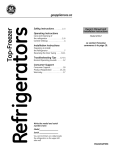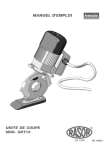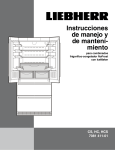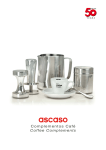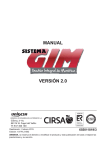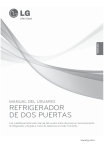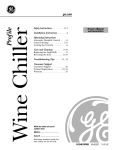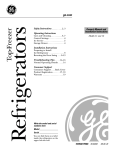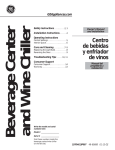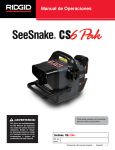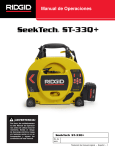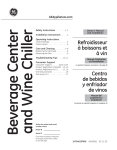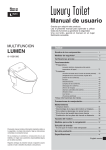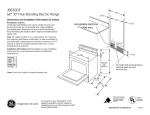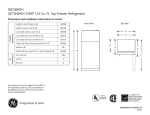Download Installation Instructions
Transcript
Top Freezer Refrigerators GEAppliances.com Safety Instructions . . . . . . . . . . . . . 2, 3 Operating Instructions Owner’s Manual and Installation Instructions GTL12 GTR10 GTR12 Care and Cleaning . . . . . . . . . . . . . . . . . .6, 7 Control Settings . . . . . . . . . . . . . . . . . . . . . . .4 Ice Service . . . . . . . . . . . . . . . . . . . . . . . . . . . . . .5 Storage Drawers . . . . . . . . . . . . . . . . . . . . . . .4 Installation Instructions Preparing to Install the Refrigerator . . . . . . . . . . . . . . . . . . . . . . 8 Reversing the Door Swing . . . . . . . . . . 9–12 Troubleshooting Tips . . . . . . . . 13–15 Normal Operating Sounds . . . . . . . . . . . 13 Consumer Support Consumer Support . . . . . . . . . . . . . . . . . . 18 Warranty (U.S.) . . . . . . . . . . . . . . . . . . . . . . 17 Write the model and serial numbers here: Model # ____________________ Serial # ____________________ You can find them on a label inside the refrigerator. 197D8071P003 49-60673 02-12 GE IMPORTANT SAFETY INFORMATION. READ ALL INSTRUCTIONS BEFORE USING. WARNING! Use this appliance only for its intended purpose as described in this Owner’s Manual. SAFETY PRECAUTIONS When using electrical appliances, basic safety precautions should be followed, including the following: This refrigerator must be properly installed and located in accordance with the Installation Instructions before it is used. Do not allow children to climb, stand or hang on the shelves in the refrigerator. They could damage the refrigerator and seriously injure themselves. Do not touch the cold surfaces in the freezer compartment, particularly when hands are damp or wet. Skin may stick to these extremely cold surfaces. Do not store or use gasoline or other flammable vapors and liquids in the vicinity of this or any other appliance. In refrigerators with automatic icemakers, avoid contact with the moving parts of the ejector mechanism, or with the heating element that releases the cubes. Do not place fingers or hands on the automatic icemaking mechanism while the refrigerator is plugged in. Keep fingers out of the “pinch point” areas; clearances between the doors and between the doors and cabinet are necessarily small. Be careful closing doors when children are in the area. Unplug the refrigerator before cleaning and making repairs. NOTE: We strongly recommend that any servicing be performed by a qualified individual. Turning the control to the COLD position does not remove power to the light circuit. Do not refreeze frozen foods which have thawed completely. Before replacing a burned-out light bulb, the refrigerator should be unplugged in order to avoid contact with a live wire filament. (A burned-out light bulb may break when being replaced.) DANGER! RISK OF CHILD ENTRAPMENT PROPER DISPOSAL OF THE REFRIGERATOR Child entrapment and suffocation are not problems of the past. Junked or abandoned refrigerators are still dangerous…even if they will sit for “just a few days.” If you are getting rid of your old refrigerator, please follow the instructions below to help prevent accidents. Before You Throw Away Your Old Refrigerator or Freezer: Refrigerants All refrigeration products contain refrigerants, which must be removed prior to product disposal. If you are getting rid of an old refrigeration product, check with the company handling the disposal about what to do. Take off the doors. Leave the shelves in place so that children may not easily climb inside. USE OF EXTENSION CORDS Because of potential safety hazards under certain conditions, we strongly recommend against the use of an extension cord. 2 However, if you must use an extension cord, it is absolutely necessary that it be a UL-listed, 3-wire, groundingtype appliance extension cord having a grounding-type plug and outlet and that the electrical rating of the cord be 15 amperes (minimum) and 120 volts. GEAppliances.com WARNING! HOW TO CONNECT ELECTRICITY Do not, under any circumstances, cut or remove the third (ground) prong from the power cord. For personal safety, this appliance must be properly grounded. The power cord of this appliance is equipped with a 3-prong (grounding) plug which mates with a standard 3-prong (grounding) wall outlet to minimize the possibility of electric shock hazard from this appliance. Have the wall outlet and circuit checked by a qualified electrician to make sure the outlet is properly grounded. Where a standard 2-prong wall outlet is encountered, it is your personal responsibility and obligation to have it replaced with a properly grounded 3-prong wall outlet. The refrigerator should always be plugged into its own individual electrical outlet which has a voltage rating that matches the rating plate. This provides the best performance and also prevents overloading house wiring circuits which could cause a fire hazard from overheated wires. Never unplug your refrigerator by pulling on the power cord. Always grip plug firmly and pull straight out from the outlet. Repair or replace immediately all power cords that have become frayed or otherwise damaged. Do not use a cord that shows cracks or abrasion damage along its length or at either end. When moving the refrigerator away from the wall, be careful not to roll over or damage the power cord. READ AND FOLLOW THIS SAFETY INFORMATION CAREFULLY. SAVE THESE INSTRUCTIONS 3 About the control on the refrigerator. There is a temperature control in the fresh food compartment as well as the freezer compartment. Initially set the control to Normal in the fresh food and freezer compartments. Allow 24 hours for the temperature to stabilize. Control Settings Adjust the fresh food control one increment at a time. Allow 12 hours after each adjustment for the refrigerator to reach the temperature you have set. Adjust the freezer control one increment at a time. Allow 12 hours after each adjustment for the freezer to reach the temperature you have set. After each adjustment, check both the freezer and the fresh food compartments. Changing the fresh food control will affect the temperature of the freezer compartment. Likewise, changing the freezer control can affect the temperature of the fresh food compartment. Control settings will vary based on personal preferences, usage and operating conditions and may require more than one adjustment. Factors that affect temperature include the amount of food in the fresh food and freezer compartments, frequency of door opening, and temperature of food when placed in either compartment. About the storage drawers. Fruit and Vegetable Drawers These storage drawers provide space to store fruits, vegetables and meats. 4 To replace the drawers and the cover above them, the door must be fully opened. In some installations, the refrigerator may have to be moved away from the wall for the door to be fully opened. About ice service. GEAppliances.com Ice Trays To release ice cubes, turn the tray upside down, hold it over a container and twist both ends. For only one or two ice cubes, leave the tray right-side up, twist both ends slightly and remove as many cubes as you want. Wash ice trays in lukewarm water only— do not put them in an automatic dishwasher. Icemaker Accessory Kit (Models GTR12 and GTL12 only) An icemaker accessory kit is available from your dealer. The IM-4A, IM-6 or equivalent accessory kit will work with your refrigerator. The water valve cover that came with the Owner’s Manual must be installed when installing the optional icemaker kit. Water Supply Kits (Models GTR12 and GTL12 only) Kits containing copper tubing, shutoff valve, fittings and instructions needed to connect the icemaker to your cold water line are available at extra cost from your dealer or from Parts and Accessories. In the U.S., call 800.626.2002. 5 Care and cleaning of the refrigerator. Cleaning the Outside Keep the outside clean. Wipe with a clean cloth lightly dampened with mild liquid dish detergent. Dry with a clean, soft cloth. Do not wipe the refrigerator with a soiled dish cloth or wet towel. These may leave a residue that can erode the paint. Do not use scouring pads, powdered cleaners, bleach or cleaners containing bleach because these products can scratch and weaken the paint finish. Protect the paint finish. The finish on the outside of the refrigerator is a high quality, baked-on paint finish. With proper care, it will stay new-looking and rust free for years. Apply a coat of kitchen/appliance wax when the refrigerator is new, and then at least twice a year. Cleaning the Inside To help prevent odors, leave an open box of baking soda in the fresh food and freezer compartments. Unplug the refrigerator before cleaning. If this is not practical, wring excess moisture out of sponge or cloth when cleaning around switches, lights or controls. Use warm water and baking soda solution— about a tablespoon (15 ml) of baking soda to a quart (1 liter) of water. This both cleans and neutralizes odors. Rinse and wipe dry. Do not wash any plastic refrigerator parts in the dishwasher. Avoid cleaning cold glass shelves (on some models) with hot water because the extreme temperature difference may cause them to break. Handle glass shelves carefully. Bumping tempered glass can cause it to shatter. Other parts of the refrigerator—including door gaskets, fruit and vegetable drawers, and all plastic parts—can be cleaned the same way. After cleaning the door gaskets, apply a thin layer of petroleum jelly to the door gaskets at the hinge side. This helps keep the gaskets from sticking and bending out of shape. Do not use cleansing powders or other abrasive cleaners. Behind the Refrigerator Once a year, move the refrigerator out and vacuum the back coils. Be careful when moving the refrigerator away from the wall. All types of floor coverings can be damaged, particularly cushioned coverings and those with embossed surfaces. 6 Pull the refrigerator straight out and return it to position by pushing it straight in. Moving the refrigerator in a side direction may result in damage to the floor covering or refrigerator. When pushing the refrigerator back, make sure you don’t roll over the power cord. Also be sure to leave a minimum of 3" between the wall and the condenser coils GEAppliances.com Replacing the Light Bulb Screw Hole Moving the control to COLD does not remove power to the light circuit. The bulb is located behind the shield in the back wall. Unplug the refrigerator. Remove the shelves (if necessary). Remove the screw. Bulb Gently remove the light shield by inserting a flat head screwdriver into the slot at the top of the shield and pop it off. Replace the bulb with a 25W appliance bulb with an E12 candelabra base. NOTE: If the bulb is not available at your local hardware store, contact GE customer service. Insert the tab at the bottom of the light shield into the light bulb housing and snap into place. Replace the screw. Replace the shelves if removed. Plug in the refrigerator. Cover Preparing for Vacation For long vacations or absences, remove food and unplug the refrigerator. Clean the interior with a baking soda solution of one tablespoon (15 ml) of baking soda to one quart (1 liter) of water. Leave the doors open. Preparing to Move Secure all loose items such as shelves and drawers by taping them securely in place to prevent damage. Be sure the refrigerator stays in an upright position during moving. 7 Refrigerator Installation Instructions Models GTL12, GTR10, GTR12 If you have questions, call 1.800.GE.CARES or visit our Website at: GEAppliances.com BEFORE YOU BEGIN CLEARANCES Read these instructions completely and carefully. Free-standing installation only. Minimum Clearances: Back – 3” from the condenser coils • IMPORTANT – Save these instructions for local inspector’s use. • IMPORTANT – Observe all governing codes and ordinances. LEVELING LEGS • Note to Installer – Be sure to leave these instructions with the Consumer. Adjustable legs at the front corners of the refrigerator should be set so the refrigerator is firmly positioned on the floor, and the front is raised just enough that the door closes easily when opened about halfway. • Note to Consumer – Keep these instructions for future reference. • Skill level – Installation of this appliance requires basic mechanical skills. To adjust the leveling legs, turn the legs clockwise to raise the refrigerator, counterclockwise to lower it. • Completion time – Refrigerator Installation 15 minutes Reversing the Door Swing 1 hour • Proper installation is the responsibility of the installer. • Product failure due to improper installation is not covered under the Warranty. To raise the refrigerator REFRIGERATOR LOCATION • Do not install the refrigerator where the temperature will go below 55°F (13°C) because it will not run often enough to maintain proper temperatures. • Install it on a floor strong enough to support it fully loaded. • Do not install it closer than 5” (13 cm) next to a range. 8 Installation Instructions REVERSING THE DOOR SWING IMPORTANT NOTES 1 REMOVE THE FREEZER DOOR When reversing the door swing: Remove the hinge cover screws (some models have lock washers with each screw), top hinge and shim. • Read the instructions all the way through before starting. Set the door on a non-scratching surface with the outside up. • Handle parts carefully to avoid scratching paint. • Set screws down by their related parts to avoid using them in the wrong places. • Provide a non-scratching work surface for the doors. IMPORTANT: Once you begin, do not move the cabinet until door-swing reversal is completed. These instructions are for changing the hinges from the right side to the left side—if you ever want to change the hinges back to the right side, follow these same instructions and reverse all references to left and right. NOTE: When removing the door, watch for washer(s) between the center hinge and the bottom of the freezer door that may stick to the door. Do not lose. Unplug the refrigerator from its electrical outlet. CAUTION: Empty all door shelves. Do not let door drop to the floor. To do so could damage the door stop. TOOLS YOU WILL NEED 8 mm Socket driver Phillips screwdriver Putty knife or thin-blade screwdriver Masking tape 9 Installation Instructions REVERSING THE DOOR SWING (CONT.) 2 REMOVE THE FRESH FOOD DOOR 3 TRANSFER TOP HINGE TO Tape the door shut with masking tape. THE LEFT Remove the center hinge and shim by removing the screws (some models have lock washers with each screw). Lift up the hinge to remove it. Using a putty knife with the edge covered with masking tape, remove the plug buttons. Be careful of the paint finish. NOTE: Some models have a washer between the center hinge and the top of the fresh food door. Do not lose. Reinstall the plug button on the right side by inserting it into the holes vacated by the top hinge screws. Reassemble the top hinge and shim on the left side, turning the screws just enough to hold the hinge in place. Remove the tape holding the door shut. Lift the fresh food door up and off the bottom hinge. Set the door outside-up on a non-scratching surface. NOTE: When removing the door, watch for washer(s) between the bottom hinge and the bottom of the fresh food door that may stick to the door. Do not lose. CAUTION: Do not let door drop to the floor. To do so could damage the door stop. 10 Installation Instructions 6 REHANG THE FRESH FOOD DOOR 4 TRANSFER BOTTOM HINGE TO THE LEFT Make sure the washer(s) are in place on the bottom hinge pin. Place the fresh food door on the bottom hinge, close the door and tape it in place with masking tape. To access the bottom hinge, move the refrigerator so it is 30 from a wall. Then carefully tip the refrigerator back until it rests against the wall. CAUTION: Be sure that the coils on the back of the refrigerator do not rest against the wall. Doing so could damage the coils. Remove the plug button from the left edge of the door and insert it into the hole on the opposite side. Plug button 30” Remove the screws (some models have washers with each screw), leveling leg and bottom hinge from the right side. Remove the leveling leg from the left side of the cabinet and install it in the right side. 7 INSTALL CENTER HINGE ON THE LEFT Reassemble the bottom hinge on the left side. NOTE: The leveling legs are not interchangeable. Remove the three plug buttons on the left side and install them on the right. Install the center hinge designed for the left side that came with the refrigerator, with the screws, spacer and washer(s) (on some models) that you removed in Step 2. 5 TRANSFER FRESH FOOD DOOR STOP TO THE LEFT Remove the door stop from the bottom of the right side of the door. Transfer the plug buttons from the bottom left side to the right side. Install the door stop on the left side. Remove the tape holding the door shut. CAUTION: When assembled correctly, the hinge is tight against the cabinet. ATTENTION: The screws must be properly tightened. Turn the screws until snug. Then tighten the screws a minimum of 1/2 turn using both hands. 11 Installation Instructions REVERSING THE DOOR SWING (CONT.) 8 TRANSFER FREEZER DOOR STOP 10 ALIGN THE DOORS TO THE LEFT Align the freezer door with the fresh food door so that the gap between the doors is even. Remove the door stop from the bottom of the right side of the door. Transfer the plug buttons from the bottom left side to the right side. Tighten the top hinge screws by turning them until snug. Then turn the screws a minimum of 1/2 turn using both hands. Install the door stop on the left side. 9 REHANG THE FREEZER DOOR Place the freezer door on the center hinge over the pin. Raise the top hinge by hand and insert the top hinge pin into the hole in the door. Then swing the door shut. Install the hinge cover over the top hinge. Transfer the plug button on top of the door to the opposite side. Plug button 12 Normal operating sounds. GEAppliances.com Newer refrigerators sound different from older refrigerators. Modern refrigerators have more features and use newer technology. Do you hear what I hear? These sounds are normal. HUMMM... WHOOSH... The new high efficiency compressor may run faster and longer than your old refrigerator and you may hear a high-pitched hum or pulsating sound while it is operating. You may hear a whooshing sound when the doors close. This is due to pressure equalizing within the refrigerator. CLICKS, POPS, CRACKS and CHIRPS You may hear the fans spinning at high speeds. This happens when the refrigerator is first plugged in, when the doors are opened frequently or when a large amount of food is added to the refrigerator or freezer compartments. The fans are helping to maintain the correct temperatures. WATER SOUNDS You may hear cracking or popping sounds when the refrigerator is first plugged in. This happens as the refrigerator cools to the correct temperature. The flow of refrigerant through the freezer cooling coils may make a gurgling noise like boiling water. The compressor may cause a clicking or chirping sound when attempting to restart (this could take up to 5 minutes). Water dropping on the defrost heater can cause a sizzling, popping or buzzing sound during the defrost cycle. Expansion and contraction of cooling coils during and after defrost can cause a cracking or popping sound. A water dripping noise may occur during the defrost cycle as ice melts from the evaporator and flows into the drain pan. On models with an icemaker, after an icemaking cycle, you may hear the ice cubes dropping into the ice bucket. Closing the door may cause a gurgling sound due to pressure equalization. 13 Before you call for service… Troubleshooting Tips Save time and money! Review the charts on the following pages first and you may not need to call for service. Problem Possible Causes What To Do Refrigerator does not operate Refrigerator in defrost cycle. • Wait about 30 minutes for defrost cycle to end. Refrigerator is unplugged. • Push the plug completely into the outlet. The fuse is blown/circuit breaker is tripped. • Replace fuse or reset the breaker. Vibration or rattling (slight vibration is normal) Front leveling legs need adjusting. • See Leveling Legs. Motor operates for long periods or cycles on and off frequently. (Modern refrigerators with more storage space and a larger freezer require more operating time. They start and stop often to maintain even temperatures.) Normal when refrigerator is first plugged in. • Wait 24 hours for the refrigerator to completely cool down. Often occurs when large amounts of food are placed in refrigerator. • This is normal. Door left open. • Check to see if package is holding door open. Hot weather or frequent door openings. • This is normal. Temperature control set at the coldest setting. •See About the control. Temperature control not set cold enough. • See About the control. Warm weather or frequent door openings. • Set the temperature control one step colder. See About the control. Door left open. • Check to see if package is holding door open. Frost or ice crystals on frozen food (frost within package is normal) Door left open. • Check to see if package is holding door open. Ice cubes have odor/taste Food transmitting odor/taste to ice cubes. • Wrap foods well. Interior of refrigerator needs cleaning. •See Care and cleaning. Door left open. • Check to see if package is holding door open. Temperature control not set cold enough. • See About the control. Fresh food or freezer compartment too warm Slow ice cube freezing 14 Too frequent or too long door openings. GEAppliances.com Problem Possible Causes What To Do Refrigerator has odor Foods transmitting odor to refrigerator. • Foods with strong odors should be tightly wrapped. • Keep an open box of baking soda in the refrigerator; replace every three months. Interior needs cleaning. • See Care and cleaning. Moisture forms on outside of refrigerator Not unusual during periods of high humidity. • Wipe surface dry. Moisture collects inside (in humid weather, air carries moisture into refrigerator when doors are opened) Too frequent or too long door openings. Interior light does not work No power at outlet. • Replace fuse or reset the breaker. Light bulb burned out. • See Replacing the light bulb. Food is freezing in the refrigerator Food too close to the air vent at the back of the refrigerator. • Move the food away from the air vent. Refrigerator control is set too cold. • Move the refrigerator control to a warmer temperature setting one increment at a time. 15 Notes. 16 Refrigerator Warranty. All warranty service provided by our Factory Service Centers, or an authorized Customer Care® technician. To schedule service on-line, visit us at GEAppliances.com, or call 800.GE.CARES (800.432.2737). Please have serial number and model number available when calling for service. Staple your receipt here. Proof of the original purchase date is needed to obtain service under the warranty. For The Period Of: GE Will Replace: One Year From the date of the original purchase Any part of the refrigerator which fails due to a defect in materials or workmanship. During this limited one-year warranty, GE will also provide, free of charge, all labor and related service to replace the defective part. What GE Will Not Cover: Service trips to your home to teach you how to use the product. Improper installation, delivery or maintenance. Failure of the product if it is abused, misused, or used for other than the intended purpose or used commercially. Loss of food due to spoilage. Replacement of house fuses or resetting of circuit breakers. Damage caused after delivery. Replacement of the water filter cartridge, if included, due to water pressure that is outside the specified operating range or due to excessive sediment in the water supply. Replacement of the light bulbs, if included, or water filter cartridge, if included, other than as noted above. Damage to the product caused by accident, fire, floods or acts of God. Incidental or consequential damage caused by possible defects with this appliance. Product not accessible to provide required service. EXCLUSION OF IMPLIED WARRANTIES—Your sole and exclusive remedy is product repair as provided in this Limited Warranty. Any implied warranties, including the implied warranties of merchantability or fitness for a particular purpose, are limited to one year or the shortest period allowed by law. This warranty is extended to the original purchaser and any succeeding owner for products purchased for home use within the USA. If the product is located in an area where service by a GE Authorized Servicer is not available, you may be responsible for a trip charge or you may be required to bring the product to an Authorized GE Service location for service. In Alaska, the warranty excludes the cost of shipping or service calls to your home. Some states do not allow the exclusion or limitation of incidental or consequential damages. This warranty gives you specific legal rights, and you may also have other rights which vary from state to state. To know what your legal rights are, consult your local or state consumer affairs office or your state’s Attorney General. Warrantor: General Electric Company. Louisville, KY 40225 17 Consumer Support. GE Appliances Website GEAppliances.com Have a question or need assistance with your appliance? Try the GE Appliances Website, 24 hours a day, any day of the year! For greater convenience and faster service, you can now download Owner’s Manuals, order parts or even schedule service on-line. Schedule Service GEAppliances.com Expert GE repair service is only one step away from your door. Get on-line and schedule your service at your convenience any day of the year! Or call 800.GE.CARES (800.432.2737) during normal business hours. Real Life Design Studio GEAppliances.com GE supports the Universal Design concept—products, services and environments that can be used by people of all ages, sizes and capabilities. We recognize the need to design for a wide range of physical and mental abilities and impairments. For details of GE’s Universal Design applications, including kitchen design ideas for people with disabilities, check out our Website today. For the hearing impaired, please call 800.TDD.GEAC (800.833.4322). Extended Warranties GEAppliances.com Purchase a GE extended warranty and learn about special discounts that are available while your warranty is still in effect. You can purchase it on-line anytime, or call 800.626.2224 during normal business hours. GE Consumer Home Services will still be there after your warranty expires. Parts and Accessories GEAppliances.com Individuals qualified to service their own appliances can have parts or accessories sent directly to their homes (VISA, MasterCard and Discover cards are accepted). Order on-line today, 24 hours every day or by phone at 800.626.2002 during normal business hours. Instructions contained in this manual cover procedures to be performed by any user. Other servicing generally should be referred to qualified service personnel. Caution must be exercised, since improper servicing may cause unsafe operation. Contact Us GEAppliances.com If you are not satisfied with the service you receive from GE, contact us on our Website with all the details including your phone number, or write to: General Manager, Customer Relations GE Appliances, Appliance Park Louisville, KY 40225 Register Your Appliance GEAppliances.com Register your new appliance on-line—at your convenience! Timely product registration will allow for enhanced communication and prompt service under the terms of your warranty, should the need arise. You may also mail in the pre-printed registration card included in the packing material. 18 Printed in China Congelador superior Refrigeradores GEAppliances.com Instrucciones de seguridad . . . . . 2, 3 Manual del propietario e instalación Instrucciones de operación GTL12 GTR10 GTR12 Cajónes de almacenamiento . . . . . . . . . .4 Configuraciones de control . . . . . . . . . . .4 Cuidado y limpieza . . . . . . . . . . . . . . . . .6, 7 Servicio de hielo . . . . . . . . . . . . . . . . . . . . . . . .5 Instrucciones de instalación Cómo invertir el vaivén de la puerta . . . . . . . . . . . . . . . . . . . . . . 9–12 Preparación para instalar el refrigerador . . . . . . . . . . . . . . . . . . . . . . . 8 Consejos para la identificación y solución de problemas . . . 13–15 Sonidos normales de la operación . . . 13 Apoyo al cliente Apoyo al cliente . . . . . . . . . . . . . . . . . . . . . 18 Garantía . . . . . . . . . . . . . . . . . . . . . . . . . . . . 16 Escriba los números de modelo y de serie aquí: Modelo # ______________________ Serie # ________________________ Usted puede encontrarlos en una etiqueta dentro del refrigerador. 197D8071P003 49-60673 02-12 GE INFORMACIONES IMPORTANTES DE SEGURIDAD. LEA PRIMERO TODAS LAS INSTRUCCIONES. ¡ADVERTENCIA! Use este aparato sólo para los fines que se describen en este Manual del propietario. PRECAUCIONES DE SEGURIDAD Cuando use electrodomésticos, siga las precauciones básicas de seguridad, incluyendo las siguientes: Antes de usarse, este refrigerador deberá estar instalado y ubicado de acuerdo con las instrucciones de instalación. No permita que los niños se suban, se paren o se cuelguen de las charolas del refrigerador. Podría dañarse el refrigerador y causarles serias lesiones. No toque las superficies frías del congelador cuando tenga las manos húmedas o mojadas. La piel se podría adherir a las superficies extremadamente frías. No guarde ni use gasolina u otros vapores o líquidos inflamables cerca de este o cualquier otro aparato. Si su refrigerador tiene un dispositivo automático para hacer hielo, evite el contacto con las partes móviles del mecanismo de expulsión, o con el elemento calefactor localizado en la parte inferior del dispositivo para hacer hielo. No ponga los dedos ni las manos en el mecanismo automático para hacer hielo mientras el refrigerador esté conectado. Aleje los dedos fuera de las áreas donde se puede pinchar los dedos; los espacios entre las puertas y entre las puertas y los gabinetes son necesariamente estrechos. Cierre las puertas con cuidado en la presencia de los niños. Desconecte el refrigerador antes de limpiarlo o efectuar reparaciones. NOTA: Recomendamos enfáticamente encargar cualquier servicio a un personal calificado. El torneado del control a la posición COLD no quita energía al circuito ligero. Do not refreeze frozen foods which have thawed completely. Antes de substituir una bombilla quemada, el refrigerador debe ser desenchufado para evitar el contacto con un filamento del alambre vivo. (La bombilla quemada de A puede romperse al ser substituido.) ¡PELIGRO! RIESGO DE QUE UN NIÑO PUEDA QUEDAR ATRAPADO DESHACERSE DEBIDAMENTE DE SU REFRIGERADOR El atrapamiento y la sofocación de los niños no son un problema del pasado. Los refrigeradores abandonados son un peligro…aunque sea sólo por “pocos días.” Si se deshace de su viejo refrigerador, por favor siga las instrucciones abajo para ayudarnos a prevenir algún accidente. Antes de deshacerse de su viejo refrigerador o congelador: Refrigerantes Todos los aparatos de refrigeración contienen refrigerantes, los cuales se deben retirar antes de la eliminación del producto de acuerdo con la ley federal. Si va a desechar algún aparato antiguo de refrigeración, consulte con la compañía a cargo de desechar el aparato para saber qué hacer. Quite las puertas. Deje los entrepaños en su sitio para que los niños no se suban. USO DE CABLES DE EXTENSION Debido a los accidentes potenciales que pudieran ocurrir bajo determinadas condiciones, se recomienda estrictamente no usar cables de extensión. 2 Sin embargo, si decidiera usarlos, es absolutamente necesario que sea del tipo UL trifilar para aparatos y cuente con una clavija con conexión a tierra y que el cable eléctrico sea de 15 amperios (mínimo) y 120 voltios. GEAppliances.com ¡ADVERTENCIA! COMO CONECTAR LA ELECTRICIDAD Bajo ninguna circunstancia debe cortar o quitar la tercera punta (tierra) de la clavija. Para su seguridad personal, este aparato deberá conectarse debidamente a tierra. El cable eléctrico de este aparato está equipado con una clavija de tres puntas (tierra) que enchufa en un contacto estándar de pared de tres salidas (tierra) para reducir al mínimo la posibilidad de daños por un choque eléctrico con este aparato. Haga que un electricista calificado verifique el enchufe de la pared y el circuito para asegurarse que la salida esté conectada debidamente a tierra. Donde se disponga sólo de un contacto de pared con salida para dos puntas, es su responsabilidad personal y su obligación reemplazarlo por un contacto adecuado para tres puntas con conexión a tierra. El refrigerador deberá conectarse siempre en su propio contacto eléctrico individual que tenga un voltaje que vaya de acuerdo con la tabla de clasificación. Esto garantiza la mejor ejecución y evita la sobrecarga del circuito eléctrico de la casa y los daños a causa del sobrecalentamiento de los cables. Nunca desconecte el refrigerador jalando el cable. Tome siempre firmemente la clavija y sáquela del contacto sin doblarla. Repare o reemplace inmediatamente todos los cables eléctricos de servicio que se hayan desgastado o dañado en alguna otra forma. No utilice cables que muestren roturas o daños por abrasión a lo largo de éste ni en la clavija o en alguno de sus extremos. Al alejar su refrigerador de la pared, cuide que no pase sobre el cable o lo dañe. FAVOR DE LEER Y SEGUIR CUIDADOSAMENTE LAS PRECAUCIONES DE SEGURIDAD. GUARDE ESTAS INSTRUCCIONES 3 Sobre el control del refrigerador. Hay un control de temperatura en el compartimento de alimentos frescos y en el compartimento del congelador. Inicialmente configure el control en Normal de los compartimentos de alimentos frescos y del congelador. Deje pasar 24 horas hasta que la temperatura se estabilice. Configuraciones de control Ajuste el control de alimentos frescos subiendo una unidad por vez. Permita que transcurran 12 horas después de cada ajuste para que el refrigerador alcance la nueva temperatura configurada. Después de cada ajuste, controle los compartimentos del congelador y de alimentos frescos. Cambiar el control de alimentos frescos afectará la temperatura del compartimento del congelador. Del mismo modo, cambiar el control del congelador afectará la temperatura del compartimento de alimentos frescos. Ajuste el control del congelador un incremento por vez. Permita que transcurran 12 horas después de cada ajuste para que el refrigerador alcance la nueva temperatura configurada. Las configuraciones de control varían en base a las preferencias personales, uso y condiciones de operación y pueden requerir más de un ajuste. Los factores que afectan la temperatura incluyen la cantidad de alimentos en los compartimentos de alimentos frescos y del congelador, la frecuencia de apertura de la puerta y la temperatura de los alimentos cuando se los coloca en cualquiera de los dos compartimentos. Sobre los cajones de almacenamiento. Cajones de frutas y vegetales Estos cajones de almacenamiento ofrecen espacio para almacenar frutas, vegetales y carnes. 4 Para reemplazar los cajones y la tapa que los cubre, la puerta debe estar completamente abierta. En algunas instalaciones, el refrigerador puede tener que alejarse de la pared para que la puerta pueda abrirse por completo. Sobre el servicio de hielo. GEAppliances.com Bandejas para cubitos de hielo Para liberar los cubitos de hielo, dé vuelta la bandeja, sosténgala sobre un recipiente y retuerza ambos extremos. Para sólo uno o dos cubitos de hielo, deje la bandeja hacia arriba, retuerza ambos extremos ligeramente y quite todos los cubitos que desee. Lave las bandejas para cubitos de hielo sólo en agua tibia—no las coloque en el lavaplatos. Kit de accesorios para la máquina de hielo (Sólo modelos GTR12 y GTL12) Su vendedor tiene disponible un kit de accesorios para la máquina de hielo. El IM-4A, IM-6 o kit de accesorios equivalente funcionará con su refrigerador. La tapa de la válvula de agua provista junto con el manual del usuario se debe instalar al realizar la instalación del kit opciona de la máquina de hacer hielo. Kits de suministro de agua (Sólo modelos GTR12 y GTL12) Su vendedor o Piezas y Accesorios ponen a su alcance, a un costo extra, kits que contienen tuberías de cobre, una válvula de cierre, accesorios e instrucciones necesarias para conectar la máquina de hielo a su línea de agua fría. En los EE.UU., llame al 800.626.2002. 5 Cuidado y limpieza del refrigerador. Limpieza de la parte exterior Mantenga la parte exterior limpia. Límpiela con un paño ligeramente humedecido con un detergente líquido para platos no agresivo. Seque con un paño suave y limpio. No limpie el refrigerador con un repasador sucio o con una toalla mojada. Estos pueden dejar un residuo que puede desgastar la pintura. No utilice esponjillas abrasivas, limpiadores en polvo, blanqueadores o limpiadores que contengan blanqueadores porque estos productos pueden rayar y dañar el acabado de la pintura. Proteja el acabado de la pintura. El acabado de la parte exterior del refrigerador es de una pintura cocida de alta calidad. Con los cuidados adecuados, permanecerá como nueva y libre de herrumbre durante años. Aplique una mano de cera para cocinas/ aparatos al refrigerador nuevo, y luego por lo menos dos veces por año. Limpieza de la parte interior Para ayudar a prevenir olores, deje una caja abierta de bicarbonato de sodio en los compartimentos de alimentos frescos y del congelador. Desenchufe el refrigerador antes de limpiarlo. Si esto no resulta práctico, seque la humedad excesiva con una esponja o paño cuando limpie alrededor de los interruptores, luces o controles. Utilice una solución de agua tibia con bicarbonato de sodio—alrededor de una cucharada (15 ml) de bicarbonato de sodio y un cuarto de galón (1 litro) de agua. Esta solución limpia y neutraliza los olores. Enjuague y seque con un paño. Después de limpiar las juntas de la puerta, aplique una fina capa de vaselina a las juntas sobre el lado de la bisagra. Esto ayuda a que las juntas no se peguen y que no se deformen. No utilice polvos limpiadores u otros limpiadores abrasivos. No lave ninguna pieza plástica del refrigerador en el lavaplatos. No limpie los estantes de vidrio fríos (en algunos modelos) con agua caliente porque pueden quebrarse debido a la extrema diferencia de temperatura. Maneje los estantes de vidrio con cuidado. Golpear el vidrio templado puede hacerlo quebrar. Otras piezas del refrigerador—incluyendo juntas de las puertas, cajones para frutas y vegetales y todas las piezas plásticas— pueden limpiarse de la misma manera. Detrás del refrigerador Una vez al año, quite el refrigerador y aspire las serpentinas traseras. Tenga cuidado al alejar el refrigerador de la pared. Todos los tipos de pisos pueden dañarse, en especial los recubrimientos acolchados y los que tienen superficies en relieve. 6 Tire del refrigerador hacia afuera en forma recta y devuélvala a su posición también en forma recta. Mover el refrigerador de costado puede provocar daños al recubrimiento del piso o al refrigerador. Cuando empuje el refrigerador hacia atrás, asegúrese de no aplastar el cable de energía. Además asegúrese de dejar un mínimo de 3 entre la pared y las serpentinas del condensador. GEAppliances.com Cómo reemplazar las bombillas de luz Orificio para tornillo Desplazar el control a la posición COLD (fría) no elimina la corriente de electricidad dirigida al circuito de la luz. La bombilla se encuentra ubicada detrás de la protección en la pared trasera. Desenchufe el refrigerador. Retire los estantes (si fuera necesario). Quite el tornillo. Bombilla Con cuidado quite la protección de la luz introduciendo un destornillador plano dentro de la ranura en la parte superior de la protección y ejerciendo presión. Reemplácela con una bombilla para electrodomésticos de 25W con una base de candelabro E12. NOTA: Si la bombilla no está disponible en su tienda local, comuníquese con el servicio al cliente de GE. Introduzca la lengüeta en la parte inferior de la protección de la luz dentro de la carcasa de la bombilla de luz y trábela en su lugar. Coloque el tornillo. Vuelva a colocar los estantes si los ha quitado. Enchufe el refrigerador. Tapa Preparación para vacaciones Durante largas vacaciones o ausencias, quite los alimentos y desenchufe el refrigerador. Limpie la parte interior con una solución compuesta por una cucharada bicarbonato de sodio (15 ml) y un cuarto (1 litro) de agua. Deje las puertas abiertas. Preparación para una mudanza Fije todos los elementos sueltos como estantes o cajones asegurándolos bien con cinta adhesiva para evitar daños. Asegúrese de que el refrigerador quede en posición vertical durante la mudanza. 7 Instrucciones deInstalación Refrigerador Modelos GTL12, GTR10, GTR12 ¿Preguntas? Llame al 800.GE.CARES (800.432.2737) o bien Visite nuestra página Web: GEAppliances.com ANTES DE COMENZAR DISTANCIAS Lea estas instrucciones por completo y con detenimiento. Sólo instalación independiente. Despeje Mínimo: Parte trasera – 3” desde las serpentinas del condensador IMPORTANTE – • Guarde estas instrucciones para el uso de inspectores locales. • Cumpla con todos los códigos y ordenanzas vigentes. IMPORTANTE – • Nota al instalador – Asegúrese de dejar estas instrucciones con el Consumidor. PATAS DE NIVELACIÓN • Nota al consumidor – Conserve estas instrucciones para referencia futura. Deben instalarse patas ajustables en las esquinas frontales del refrigerador para que éste se encuentre bien asentado en el piso, y el frente debe estar elevado lo suficiente para que la puerta cierre fácilmente cuando se abre hasta alrededor de la mitad. • Nivel de capacidad – La instalación de este aparato requiere capacidades mecánicas básicas. • Tiempo de finalización – Instalación del refrigerador 15 minutos Invertir el vaivén de la puerta 1 hora Para ajustar las patas de nivelación, gire las patas patas en sentido de las agujas del reloj para levantar el refrigerador o en sentido contrario a las agujas del reloj para bajarlo. • El instalador tiene la responsabilidad de efectuar una instalación adecuada. • La Garantía no cubre las fallas del producto debido a una instalación incorrecta. UBICACIÓN DEL REFRIGERADOR • No instale el refrigerador donde la temperatura pueda ser menor a los 55°F (13°C) porque no funcionará con la regularidad suficiente para mantener las temperaturas adecuadas. Para elevar el refrigerador • Instálelo sobre un piso lo suficientemente resistente para soportarlo completamente cargado. • No lo instale a menos 5” (13 cm) de una cocina. 8 Instrucciones de instalación CÓMO INVERTIR EL VAIVÉN DE LA PUERTA NOTAS IMPORTANTES 1 QUITE LA PUERTA DEL CONGELADOR Cuando invierta el vaivén de la puerta: Quite los tornillos de la tapa de la bisagra (algunos modelos cuentan con arandelas de presión con cada tornillo), la bisagra superior y la cuña. • Lea por completo todas las instrucciones antes de comenzar. • Manipule las piezas con cuidado para no rayar la pintura. Coloque la puerta sobre una superficie que no raye con la parte exterior hacia arriba. • Separe los tornillos por sus piezas relacionadas para evitar usarlos en lugares equivocados. • Coloque las puertas sobre una superficie de trabajo que no raye. IMPORTANTE: Una vez que haya comenzado, no mueva el gabinete hasta haber finalizado la inversión del vaivén de la puerta. Estas instrucciones son para cambiar las bisagras del lado derecho al lado izquierdo; si alguna vez desea cambiarlas de nuevo al lado derecho, siga las mismas instrucciones e invierta todas las referencias de la izquierda a la derecha. NOTA: Cuando quite la puerta, preste atención a las arandelas entre la bisagra central y la parte inferior de la puerta de congelador porque pueden pegarse a la puerta. No las pierda. Desenchufe el refrigerador del tomacorriente. Vacíe todos los estantes de la puerta. PRECAUCIÓN: No deje caer la puerta al piso. Si esto sucede, puede dañarse la traba de la puerta. HERRAMIENTAS NECESARIAS Llave de cubo de 8 mm Destornillador de estrella Espátula o destornillador de lados finos Cinta adhesiva 9 Instrucciones de instalación CÓMO INVERTIR EL VAIVÉN DE LA PUERTA (CONT.) 2 QUITE LA PUERTA DE ALIMENTOS 3 TRANSFIERA LA BISAGRA SUPERIOR FRESCOS A LA IZQUIERDA Cierre la puerta con cinta adhesiva. Utilizando una espátula con los bordes recubiertos con cinta adhesiva, quite los botones obturadores. Tenga cuidado con el acabado de pintura. Quite la bisagra central y cuña sacando los tornillos (algunos modelos cuentan con arandelas de presión con cada tornillo). Levante la bisagra para quitarla. Vuelva a instalar el botón obturador en el lado derecho introduciéndolo en los orificios dejados por los tornillos de la bisagra superior. NOTA: Algunos modelos cuentan con una arandela entre la bisagra central y la parte superior de la puerta de alimentos frescos. No la pierda. Vuelva a armar la bisagra superior y la cuña sobre el lado izquierdo, girando los tornillos lo suficiente para mantener la bisagra en su lugar. Quite la cinta que sostiene la puerta cerrada. Levante la puerta de alimentos frescos y quítela de la bisagra inferior. Coloque la puerta con la parte exterior hacia arriba sobre una superficie que no raye. NOTA: Cuando quite la puerta, preste atención a las arandelas entre la bisagra central y la parte inferior de la puerta de congelador porque pueden pegarse a la puerta. No las pierda. PRECAUCIÓN: No deje caer la puerta al piso. Si esto sucede, puede dañarse la traba de la puerta. 10 Instrucciones de instalación 6 VUELVA A COLGAR LA PUERTA 4 TRANSFIERA LA BISAGRA INFERIOR DE ALIMENTOS FRESCOS A LA IZQUIERDA Asegúrese que las arandelas estén en su lugar en el perno inferior de la bisagra. Coloque la puerta de alimentos frescos en la bisagra inferior, cierre la puerta y ciérrela con cinta adhesiva. Para acceder a la bisagra inferior, mueva el refrigerador a 30 de la pared. Luego incline con cuidado el refrigerador hacia atrás hasta que descanse sobre la pared. PRECAUCIÓN: Asegúrese de que las serpentinas ubicadas en la parte trasera del refrigerador no descansen contra la pared. Al hacerlo podrían dañarse las serpentinas. Quite el botón obturador del lado izquierdo de la puerta e introdúzcalo dentro del orificio del lado opuesto. Botón obturador 30” (76.2cm) Quite los tornillos (algunos modelos cuentan con arandelas en cada tornillo), la pata de nivelación y la bisagra inferior del lado derecho. Quite la pata de nivelación del lado izquierdo del gabinete e instálela en el lado derecho. 7 INSTALE LA BISAGRA CENTRAL EN LA IZQUIERDA Vuelva a armar la bisagra inferior en el lado izquierdo. Quite los tres botones obturadores sobre el lado izquierdo e instálelos sobre el derecho. NOTA: Las patas de nivelación no son intercambiables. Instale la bisagra central diseñada para el lado izquierdo que vino con el refrigerador, con los tornillos espaciador y arandelas (en algunos modelos) que se quitaron en el Paso 2. 5 TRANSFIERA LA TRABA DE LA PUERTA DE ALIMENTOS FRESCOS A LA IZQUIERDA Quite la traba de la puerta de la parte inferior del lado derecho de la puerta. Transfiera los botones obturadores del lado inferior izquierdo al lado derecho. Quite la cinta que sostiene la puerta cerrada. PRECAUCIÓN: Instale la traba de la puerta sobre el lado izquierdo. Cuando se arma correctamente, la bisagra queda firme contra el gabinete. 11 ATENCIÓN: Los tornillos deben estar bien ajustados. Gire los tornillos hasta que queden firmes. Luego ajuste los tornillos con 1/2 vuelta como mínimo utilizando ambas manos. Instrucciones de instalación CÓMO INVERTIR EL VAIVÉN DE LA PUERTA (CONT.) 8 TRANSFIERA LA TRABA DE 10 ALINEE LAS PUERTAS LA PUERTA DEL CONGELADOR A LA IZQUIERDA Alinee la puerta del congelador con la puerta de alimentos frescos para que el espacio entre ellas se encuentre equilibrado. Quite la traba de la puerta de la parte inferior del lado derecho de la puerta. Transfiera los botones obturadores del lado inferior izquierdo al lado derecho. Ajuste los tornillos de la bisagra inferior girándolos hasta que queden firmes. Luego gire los tornillos 1/2 vuelta como mínimo utilizando ambas manos. Instale la traba de la puerta sobre el lado izquierdo. 9 VUELVA A COLGAR LA PUERTA DEL CONGELADOR Coloque la puerta del congelador en la bisagra central sobre el perno. Levante la bisagra superior a mano e introduzca el perno de la bisagra superior dentro del orificio de la puerta. Luego cierre la puerta. Instale la tapa de la bisagra sobre la bisagra superior. Transfiera el botón obturador de la parte superior de la puerta al lado opuesto. Botón obturador 12 Sonidos normales de la operación. GEAppliances.com Los refrigeradores más nuevos producen sonidos diferentes a los modelos más antiguos. Los refrigeradores modernos tienen más funciones y usan tecnología más reciente. ¿Usted escucha lo que yo escucho? Estos sonidos son normales. HUMMM... WHOOSH... El nuevo compresor de alta eficiencia puede funcionar más rápido y durar más que el de su refrigerador anterior y puede escuchar un zumbido de tono alto o un sonido pulsante mientras opera. Puede escuchar un sonido de soplido cuando las puertas se cierran. Esto se debe a que la presión se está estabilizando dentro del refrigerador. Puede escuchar los ventiladores moviéndose a gran velocidad. Esto pasa cuando el refrigerador se conecta por primera vez, cuando las puertas se abren frecuentemente o cuando se guarda gran cantidad de alimentos en el refrigerador o en los compartimientos del congelador. Los ventiladores están ayudando a mantener las temperaturas correctas. CHASQUIDOS, ESTALLIDOS, CRUJIDO Puede escuchar sonidos como de crujido o estallidos cuando el refrigerador se conecta por primera vez. Esto pasa a medida que el refrigerador se enfría hasta la temperatura correcta. El compresor puede causar un chasquido o un gorjeo cuando intenta volver a arrancar (esto puede tomar hasta 5 minutos). Expansión y contracción de las bobinas durante o después del ciclo de descongelación puede causar sonidos como de crujido o estallidos. En modelos con máquina de hielos, después de completar un ciclo de hacer hielo, se pueden escuchar los cubos de hielo cuando caen a la bandeja de hielos. SONIDOS DE AGUA El fluido del refrigerante a través de las bobinas puede producir un sonido de borboteo como de agua hirviendo. El agua que cae en el calentador de descongelación puede causar un chisporroteo, estallido o zumbido durante el ciclo de descongelación. Un ruido de agua cayendo se puede escuchar durante el ciclo de descongelación a medida que el hielo se derrite del evaporador y fluye hacia la bandeja de drenaje. El cierre de las puertas puede producir un sonido de gorgoteo debido a la estabilización de la presión. 13 Antes de solicitar un servicio… Solucionar problemas ¡Ahorre tiempo y dinero! Revise las tablas en las siguientes páginas y tal vez no necesitará de solicitar un servicio. Problema Causas Posibles Qué hacer El refrigerador no funciona El refrigerador está en el ciclo de descongelado. • Espere alrededor de 30 minutos para que termine el ciclo de descongelado. El refrigerador está desenchufado. • Presione el enchufe completamente dentro del tomacorriente. Fusible quemado/interruptor de circuitos accionado. • Cambie el fusible o reconfigure el interruptor. Vibración o golpeteo (una leve vibración es normal) Las patas de nivelación frontales • Ver Patas de nivelación. deben ajustarse. El motor funciona por períodos prolongados o se enciende y apaga frecuentemente (Los refrigeradores modernos con más espacio de almacenamiento y un congelador más grande requieren más tiempo de operación. Se encienden y apagan a menudo para mantener temperaturas parejas) Normal cuando el refrigerador se enchufa por primera vez. • Espere 24 horas para que el refrigerador se enfríe por completo. Esto ocurre a menudo cuando se colocan grandes cantidades de alimentos en el refrigerador. • Esto es normal. Se dejó la puerta abierta. • Constate que un paquete no esté manteniendo la puerta abierta. Clima caluroso o aperturas frecuentes de la puerta. • Esto es normal. Control de temperatura configurado en el nivel más frío. •Ver Sobre el control. El control de temperatura no se ha configurado lo suficientemente frío. • Ver Sobre el control. Clima caluroso o aperturas frecuentes de la puerta. • Configure el control de temperatura un paso más frío. Ver Sobre el control. Se dejó la puerta abierta. • Constate que un paquete no esté manteniendo la puerta abierta. Escarcha o cristales de hielo sobre los alimentos congelados (la escarcha dentro del paquete es normal) Se dejó la puerta abierta. • Constate que un paquete no esté manteniendo la puerta abierta. Los cubitos de hielo tienen olor/sabor Los alimentos transmiten olor/sabor a los cubitos de hielo • Envuelva bien los alimentos. Debe limpiarse la parte interior del refrigerador. •Ver Cuidado y limpieza. Se dejó la puerta abierta. • Constate que un paquete no esté manteniendo la puerta abierta. El control de temperatura no se ha configurado lo suficientemente frío. • Ver Sobre el control. El compartimento de alimentos frescos o del congelador están muy calientes Los cubitos de hielo tardan en hacerse 14 Aperturas de la puerta muy frecuentes o muy prolongadas GEAppliances.com Problema Causas Posibles Qué hacer El refrigerador tiene olor Los alimentos transmiten olor al refrigerador. • Los alimentos con olores fuertes deben envolverse bien. • Mantenga una caja abierta de bicarbonato de sodio en el refrigerador; cámbiela casa tres meses. Debe limpiarse la parte interna. • Ver Cuidado y limpieza. Se forma humedad en la parte exterior del refrigerador Resulta común durante períodos • Seque la superficie con un paño. de humedad elevada. Se acumula humedad en el interior (en climas húmedos, el aire transporta humedad dentro del refrigerador cuando se abren las puertas) Aperturas de la puerta muy frecuentes o muy prolongadas. La luz interior no funciona El tomacorriente no recibe energía. • Cambie el fusible o reconfigure el interruptor. Los alimentos se congelan en el refrigerador Los alimentos se encuentran muy cerca de la ventilación de aire en la parte trasera del refrigerador. La bombilla de luz se ha quemado. • Ver Cómo cambiar la bombilla de luz. • Aleje los alimentos de la ventilación de aire. El control del refrigerador está • Mueva el control del refrigerador a una configuración configurado en una temperatura más elevada subiendo una unidad por vez. muy baja. 15 Garantía del Refrigerador. (Para consumidores en los EE.UU.) Todos los servicios de garantía los proporcionan nuestros Centros de Reparación de Fábrica o nuestros técnicos Customer Care ® autorizados. Para concertar una cita de reparación, en línea, visíte nos al GEAppliances.com, o llame al 800.GE.CARES (800.432.2737). Cuando llame para solicitar servicio, por favor tenga a mano el número de serie y el número de modelo. Grape aquí su recibo. Se requiere facilitar prueba de la fecha de compra original para obtener un servicio bajo la garantía. Por el período de: GE reemplazará: Un año A partir de la fecha de la compra original Cualquier parte del refrigerador que falle debido a defectos en los materiales o en la fabricación. Durante esta garantía limitada de un año, GE también proporcionará, sin costo alguno, toda la mano de obra y el servicio relacionado—para reemplazar partes defectuosas. Lo que GE no cubrirá: Viajes de servicio a su hogar para enseñarle cómo usar el producto. Instalación o entrega inapropiada, o mantenimiento impropio. Fallas del producto si hay abuso, mal uso, o uso para otros propósitos que los propuestos, o uso para fines comerciales. Pérdida de alimentos por averías. Causar daños después de la entrega. Reemplazo de fusibles de su hogar o reajuste de interruptores de circuito. Reemplazo del cartucho del filtro para agua, si incluidos, debido a presión de agua afuera de las limites de operación especificados o sedimento excesivo en el suministro de agua. Reemplazo de las bombillas, si incluidos, o los filtros de agua, si incluidos otro entonces según lo observado arriba. Daño al producto causado por accidente, fuego, inundaciones, o actos de Dios. Daño incidental o consecuencial causado por posibles defectos con el aparato. Producto no accesible para facilitar el servicio requerido. EXCLUSIÓN DE GARANTÍAS IMPLÍCITAS—Su único y exclusivo derecho es la reparación del producto, tal y como se indica en esta Garantía limitada. Cualquier garantía implícita, incluyendo las garantías implícitas de comerciabilidad o adecuación para un fin determinado, están limitadas a un año o el período de tiempo más breve permitido por la ley. Esta garantía se extiende al comprador original y cualquier comprador posterior de productos comprados para uso residencial dentro de Estados Unidos. Si el producto está situado en un área que no dispone de servicio por parte de un proveedor de servicio autorizado de GE, podría tener que hacerse cargo de los costes de envío o bien podría solicitársele que lleve el producto a una centro de servicio de GE autorizado para realizar la reparación. En Alaska, la garantía excluye el costo de envío o las visitas de servicio a su casa. Algunos estados no permiten la exclusión o las limitaciones de daños incidentales o consecuenciales. Esta garantía da derechos legales específicos, y usted podría tener otros derechos que variarán de estado a estado. Para saber cuáles son sus derechos legales, consulte a la oficina de asuntos del consumidor local o la oficina del Attorney General en su localidad. Garante: General Electric Company. Louisville, KY 40225 16 Notas. GEAppliances.com 17 Servicio al consumidor. Página Web de GE Appliances GEAppliances.com ¿Tiene alguna pregunta sobre su electrodoméstico? ¡Pruebe la página Web de GE Appliances, 24 horas al día, cualquier día del año! Para mayor conveniencia y servicio más rápido, ya puede descargar los Manuales de los Propietarios, pedir piezas o incluso hacer una cita en línea para que vengan a realizar una reparación. Solicite una reparación GEAppliances.com El servicio de expertos GE está a tan sólo un paso de su puerta. ¡Entre en línea y solicite su reparación cuando le venga cualquier día del año! O llame al 800.GE.CARES (800.432.2737) durante horas normales de oficina. Real Life Design Studio (Estudio de diseño para la vida real) GEAppliances.com GE apoya el concepto de Diseño Universal—productos, servicios y ambientes que pueden usar gente de todas las edades, tamaños y capacidades. Reconocemos la necesidad de diseñar para una gran gama de habilidades y dificultades físicas y mentales. Para más detalles cobre las aplicaciones de GE Diseño Universal, incluyendo ideas de diseño para la cocina para personas con discapacidades, mire nuestra página Web hoy mismo. Para personas con dificultades auditivas, favor de llamar al 800.TDD.GEAC (800.833.4322). Garantías ampliadas GEAppliances.com Compre una garantía ampliada y obtenga detalles sobre descuentos especiales disponibles mientras su garantía está aún activa. Puede comprarla en línea en cualquier momento, o llamar al (800.626.2224) durante horas normales de oficina. GE Consumer Home Services estará aún ahí cuando su garantía termine. Piezas y accesorios GEAppliances.com Aquellos individuos con la calificación necesaria para reparar sus propios electrodomésticos pueden pedir que se les manden las piezas o accesorios directamente a sus hogares (aceptamos las tarjetas VISA, MasterCard y Discover). Haga su pedido en línea hoy, 24 horas cada día o llamar por teléfono al 800.626.2002 durante horas normales de oficina. Las instrucciones descritas en este manual cubren los procedimientos a seguir por cualquier usuario. Cualquier otra reparación debería, por regla general, referirse a personal calificado autorizado. Debe ejercerse precaución ya que las reparaciones incorrectas pueden causar condiciones de funcionamiento inseguras. Póngase en contacto con nosotros GEAppliances.com Si no está satisfecho con el servicio que recibe de GE, póngase en contacto con nosotros en nuestra página Web indicando todos los detalles así como su número de teléfono o escríbanos a: General Manager, Customer Relations GE Appliances, Appliance Park Louisville, KY 40225 Registre su electrodoméstico GEAppliances.com ¡Registre su nuevo electrodoméstico en línea—cuando usted prefiera! El registrar su producto a tiempo le proporcionará, si surgiera la necesidad, una mejor comunicación y un servicio más rápido bajo los términos de su garantía. También puede enviar su tarjeta de registro pre-impresa que se incluye en el material de embalaje. 18 Impreso en China




































